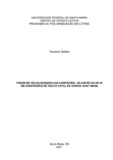| dc.creator | Gallas, Taciana | |
| dc.date.accessioned | 2021-11-16T17:21:05Z | |
| dc.date.available | 2021-11-16T17:21:05Z | |
| dc.date.issued | 2021-05-07 | |
| dc.identifier.uri | http://repositorio.ufsm.br/handle/1/22814 | |
| dc.description.abstract | This paper aims to analyze in the literary text Confissões de Ralfo (1975), by Sérgio Sant'Anna, the genres of writing of the self and the different reading pacts that make up the narrative. The perception of these distinct genres, already exposed in the title and subtitle of the narrative, led us to research the mixture between the novel and other forms of fiction and non-fiction. Thus, we divided this research into four parts, the first one being responsible for contextualizing the Brazilian scenario of the 1970s and 1980s, the moment in which Sérgio Sant'Anna begins his literary career and the period in which the process of literary hybridity becomes more evident. It is also in this period that the so-called postmodern literature, whose manifestations mix different genres and artistic languages, assumes some prominence in the field of Brazilian literature. The second part has the purpose of presenting theoretical considerations about the genres autobiography, confessions, memoirs, testimony, autofiction, diary, and correspondence, writings of the self that are registered in the text and in the paratext of Confissões de Ralfo (1975). When we realize the insertion of these different genres in the narrative, we consider it extremely important to discuss the reading pacts, a kind of tacit contract between the author and the reader. The pacts discussed are the referential, committed to a referentiality external to the literary text, and the fictional agreement, in which the reader suspends his disbelief before the fictional text. The third part presents a careful analysis of Confissões de Ralfo (1975) based on excerpts from the literary text and the paratext. The purpose is to examine how the genres of writing of the self (fictional and nonfictional) are inscribed in this novel and, also, with the analysis, address how the pacts of reading are constructed. The last chapter, finally, discusses the parody present in the expression "imaginary autobiography", as well as in other passages of the book, and also evaluates the pastiche of the writings of the self, a resource that Sérgio Sant'Anna uses to reference the genres we analyze throughout our paper. | eng |
| dc.description.sponsorship | Coordenação de Aperfeiçoamento de Pessoal de Nível Superior - CAPES | por |
| dc.language | por | por |
| dc.publisher | Universidade Federal de Santa Maria | por |
| dc.rights | Attribution-NonCommercial-NoDerivatives 4.0 International | * |
| dc.rights.uri | http://creativecommons.org/licenses/by-nc-nd/4.0/ | * |
| dc.subject | Romance | por |
| dc.subject | Pactos de leitura | por |
| dc.subject | Sérgio Sant’Anna | por |
| dc.subject | Confissões de Ralfo | por |
| dc.subject | Escritas de si | por |
| dc.subject | Novel | eng |
| dc.subject | Reading pacts | eng |
| dc.subject | Writings of the self | eng |
| dc.title | Passeios pelos bosques da confissão: as escritas de si em Confissões de Ralfo (1975), de Sérgio Sant’Anna | por |
| dc.title.alternative | Walks through the woods of confession: the writing of the self in Confissões de Ralfo (1975), by Sérgio Sant'Anna | eng |
| dc.type | Dissertação | por |
| dc.description.resumo | Este trabalho tem por objetivo analisar no texto literário Confissões de Ralfo (1975), do escritor Sérgio Sant’Anna, os gêneros das escritas de si e os diferentes pactos de leitura que compõem a narrativa. A percepção desses distintos gêneros, já expostos no título e no subtítulo da narrativa, levou-nos a pesquisar sobre a mistura entre o romance e outras formas de ficção e não-ficção. Sendo assim, dividimos a presente pesquisa em quatro partes, sendo a primeira responsável por contextualizar o cenário brasileiro dos anos 1970 e 1980, momento em que Sérgio Sant’Anna inicia sua carreira literária e período no qual o processo de hibridismo literário fica em maior evidência. É também nesse período que a literatura denominada pós-moderna, cujas manifestações misturam diferentes gêneros e linguagens artísticas, assume certa proeminência no âmbito da literatura brasileira. A segunda parte tem como propósito apresentar considerações teóricas sobre os gêneros autobiografia, confissões, memórias, testemunho, autoficção, diário e correspondência, escritas de si que estão registradas no texto e no paratexto de Confissões de Ralfo (1975). Ao percebermos a inserção desses diferentes gêneros na narrativa, consideramos de extrema importância discutir os pactos de leitura, espécie de contrato tácito entre o autor e o leitor. Os pactos abordados são o referencial, comprometido com uma referencialidade externa ao texto literário, e o acordo ficcional, no qual o leitor suspende sua descrença diante do texto de ficção. Já a terceira parte apresenta uma análise atenta de Confissões de Ralfo (1975) a partir de excertos do texto literário e do paratexto. O objetivo é examinar como os gêneros das escritas de si (ficcionais e não-ficcionais) estão inscritos nesse romance e, também, com a análise, abordar como os pactos de leitura são construídos. Por fim, o último capítulo discute a paródia presente na expressão “autobiografia imaginária”, bem como em outras passagens do livro e, ainda, avalia o pastiche das escritas de si, recurso que Sérgio Sant’Anna utiliza para referenciar os gêneros que analisamos no decorrer de nosso trabalho. | por |
| dc.contributor.advisor1 | Felippe, Renata Farias de | |
| dc.contributor.advisor1Lattes | http://lattes.cnpq.br/5454806173934935 | por |
| dc.contributor.referee1 | Mathias, Dionei | |
| dc.contributor.referee2 | Berned, Pablo Lemos | |
| dc.creator.Lattes | http://lattes.cnpq.br/9553593553534646 | por |
| dc.publisher.country | Brasil | por |
| dc.publisher.department | Letras | por |
| dc.publisher.initials | UFSM | por |
| dc.publisher.program | Programa de Pós-Graduação em Letras | por |
| dc.subject.cnpq | CNPQ::LINGUISTICA, LETRAS E ARTES::LETRAS | por |
| dc.publisher.unidade | Centro de Artes e Letras | por |



